AMD Kaveri Review: A8-7600 and A10-7850K Tested
by Ian Cutress & Rahul Garg on January 14, 2014 8:00 AM ESTIntegrated GPU Performance: BioShock Infinite
The first benchmark in our test is Bioshock Infinite, Zero Punctuation’s Game of the Year for 2013. Bioshock Infinite uses the Unreal Engine 3, and is designed to scale with both cores and graphical prowess. We test the benchmark using the Adrenaline benchmark tool and their three default settings of Performance (1280x1024, Low), Quality (1680x1050, Medium/High) and Xtreme (1920x1080, Maximum) noting down the average frame rates and the minimum frame rates.
Bioshock Infinite, Performance Settings
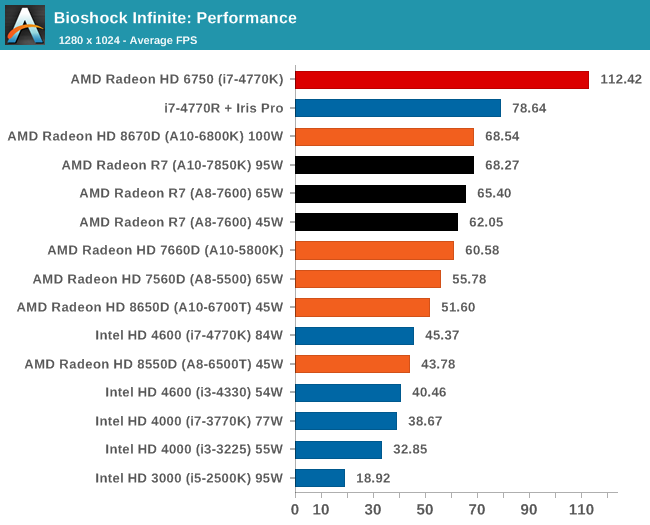
For BI: Performance we see the Iris Pro being top of the IGPs, although the next six in the list are all AMD. The Kaveri cores are all between the 6800K and 5800K for this test, and all comfortably above 60 FPS average.
Bioshock Infinite, Quality Settings

For the quality settings, the Iris Pro starts to struggle and all the R7 based Kaveri APUs jump ahead of the A10-6800K - the top two over the Iris Pro as well.
Bioshock Infinite, Xtreme Settings
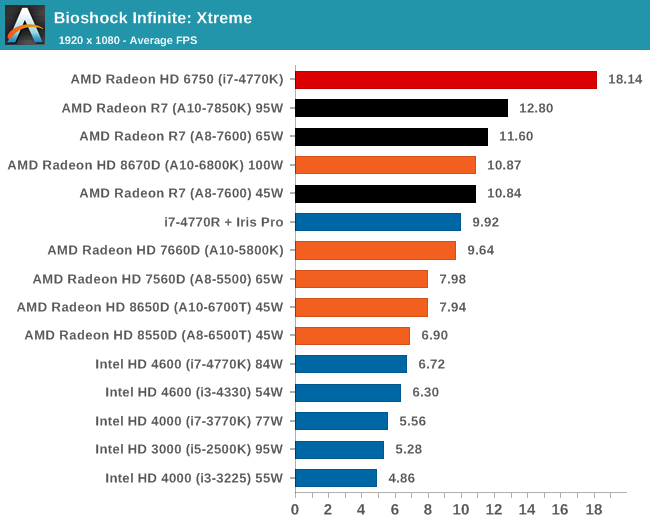
The bigger the resolution, the more the Iris Pro suffers, and Kaveri takes three out of the top four IGP results.
Integrated GPU Performance: Tomb Raider
The second benchmark in our test is Tomb Raider. Tomb Raider is an AMD optimized game, lauded for its use of TressFX creating dynamic hair to increase the immersion in game. Tomb Raider uses a modified version of the Crystal Engine, and enjoys raw horsepower. We test the benchmark using the Adrenaline benchmark tool and their three default settings of Performance (1280x1024, Low), Quality (1680x1050, Medium/High) and Xtreme (1920x1080, Maximum) noting down the average frame rates and the minimum frame rates.
Tomb Raider, Performance Settings
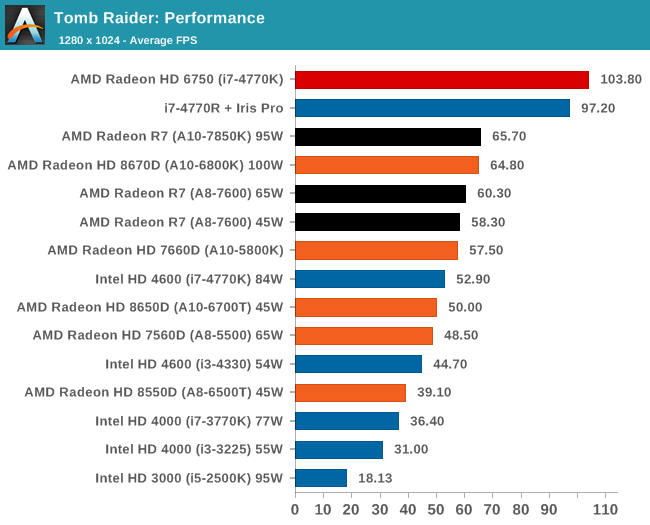
The top IGP for Richland and Kaveri are trading blows in TR.
Tomb Raider, Quality Settings

The Iris Pro takes a small lead, while the Kaveri 95W APU show little improvement over Richland. The 45W APU however is pushing ahead.
Tomb Raider, Xtreme Settings
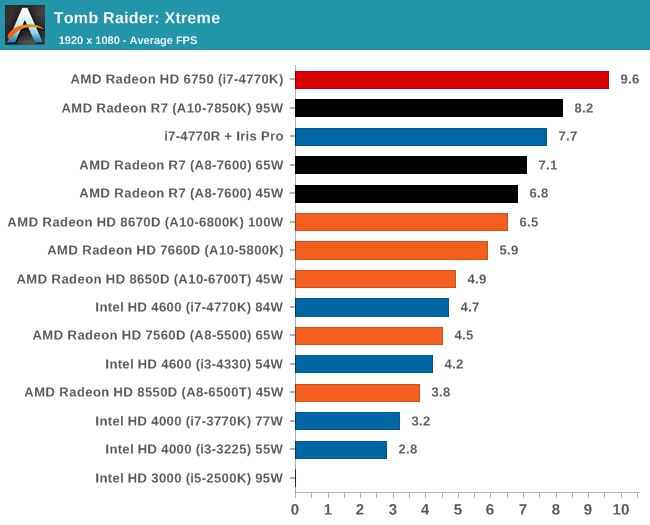
At the maximum resolution, the top Kaveri overtakes Iris Pro, and the 45W Kaveri it still a good margin ahead of the A10-6700T.
Integrated GPU Performance: F1 2013
Next up is F1 2013 by Codemasters. I am a big Formula 1 fan in my spare time, and nothing makes me happier than carving up the field in a Caterham, waving to the Red Bulls as I drive by (because I play on easy and take shortcuts). F1 2013 uses the EGO Engine, and like other Codemasters games ends up being very playable on old hardware quite easily. In order to beef up the benchmark a bit, we devised the following scenario for the benchmark mode: one lap of Spa-Francorchamps in the heavy wet, the benchmark follows Jenson Button in the McLaren who starts on the grid in 22nd place, with the field made up of 11 Williams cars, 5 Marussia and 5 Caterham in that order. This puts emphasis on the CPU to handle the AI in the wet, and allows for a good amount of overtaking during the automated benchmark. We test at three different levels again: 1280x1024 on Low, 1680x1050 on Medium and 1920x1080 on Ultra. Unfortunately due to various circumstances we do not have Iris Pro data for F1 2013.
F1 2013, Performance Settings
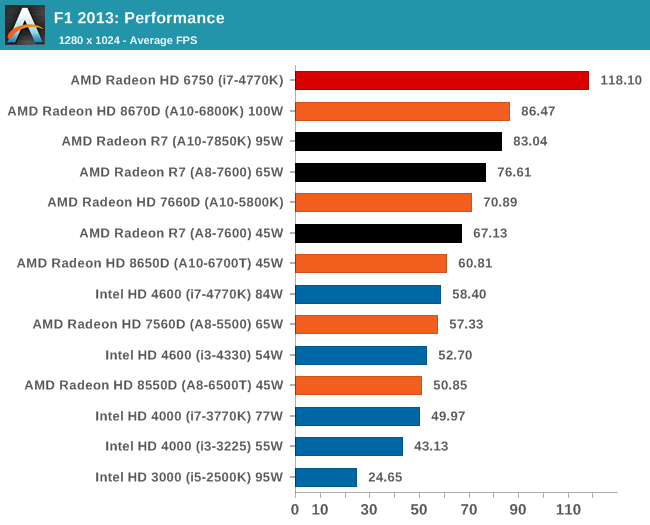
F1 likes AMD here, although moving from Kaveri to Richland at the high end seems a bit of a regression.
F1 2013, Quality Settings
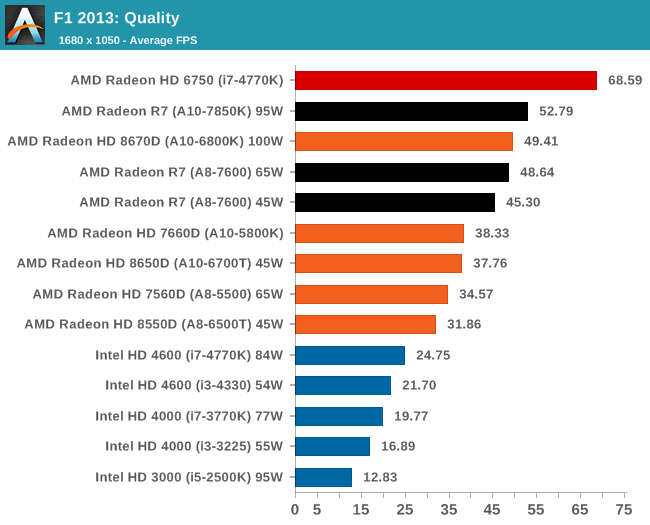
Similarly in the Quality settings, none of the Intel integrated graphics solutions can keep up with AMD, especially Kaveri.
F1 2013, Xtreme Settings

On extreme settings, at 1080p, the top Kaveri APU manages to hit over 30 FPS average during the benchmark. The other A8 Kaveri data is not too far behind.










380 Comments
View All Comments
srkelley - Wednesday, January 15, 2014 - link
Some of us don't have a lot of money. It may be only $100 but it could mean giving up on buying games just to get a more powerful rig that can't play... games (that you would be willing to buy anyway). I'd like to buy/build a system that's great all around, I'd love to have the very best. The very best is overkill and some systems while not the best are still a bit too pricey.This APU will meet nearly all of my needs and exceed quite a few of them. I'm fine with not being able to max out my settings in every game, I'll be able to max most of them out at 1920x1080 @60 fps (or higher) with this apu. If the improvements in hybrid crossfire pan out (due to decreased latency and improvement in implementation) - I may be able to buy a super cheap gpu at a much later date to cover the rest of what I would need it for. I'll also be able to cool my system for a lower price (or just use stock everything).
Even if cf is a bust, the core product let's me spend a bit more on memory, better storage, a better case and even pick up a few new games without breaking my budget (if I sell my current monitor for asking price, I may be able to use it subsidize a slightly better one at the same time!). Right now I use a netbook, a smart phone and a pc that would struggle to play the original Assassin's Creed at 30fps with a 640x480 screen resolution. The monitor, speakers and wireless keyboard set is the only nice thing about my set-up. Time to step into the future - it's more than good enough for me and people like me.
Dribble - Thursday, January 16, 2014 - link
You can buy a cheaper non-apu cpu and discrete radeon graphics card for about the same amount and that would play games better and do everything else just as well, and still give you all the AMD advantages (mantle, etc). Would also give a better upgrade path as when in the future you are better off you can more easily upgrade cpu or graphics to something faster.The APU only really wins when you need it in a very small box too (so no room for discrete graphics)
Nagorak - Wednesday, January 15, 2014 - link
Well, I will say that one place that this may actually be worthwhile is in an HTPC with a tiny case that can't even take a half height graphics card. With anything that can take a half height graphics card it's moot.mikato - Wednesday, January 15, 2014 - link
But why do you need a discrete card with an HTPC? You don't.rpsgc - Tuesday, January 14, 2014 - link
No gaming benchmarks with dGPU? (I'm not talking about Dual Graphics.) Some people are interested on how this performs purely as a CPU, seeing as AM3 is apparently dead.YuLeven - Tuesday, January 14, 2014 - link
Well, it costs US$173. You can buy a Pentium G + Radeon HD7770GE for US$175~ on Newegg today. One set gives you all-in-one subpar 720p gaming, the other goes as up as 1080p in many titles. In fact, it's nearly cruelty comparing a HD7700GE to Kaveri's GPU.Well, unless you desperately need a one-chip solution, I see Kaveri as being utterly pointless as far gaming is concerned.
Ian Cutress - Tuesday, January 14, 2014 - link
It will be the focus of my next Gaming CPU article update; retesting over a dozen CPUs for this review, at 30 hours each, wasn't an easy task.YuLeven - Wednesday, January 15, 2014 - link
Super, Ian! I can't wait for it.srkelley - Wednesday, January 15, 2014 - link
Thanks for your hard work, you and Rahul did a great job! I always love reading the reviews at Anandtech. They're very informative, easy to read and leave me with a much, much better understanding of whatever they're covering when compared to how I went into it.Drumsticks - Tuesday, January 14, 2014 - link
Any chance you can make a summary of the 65 and 45W APUs vs an i3-4330 at 54W? That would be a more apt comparison especially considering the price range.